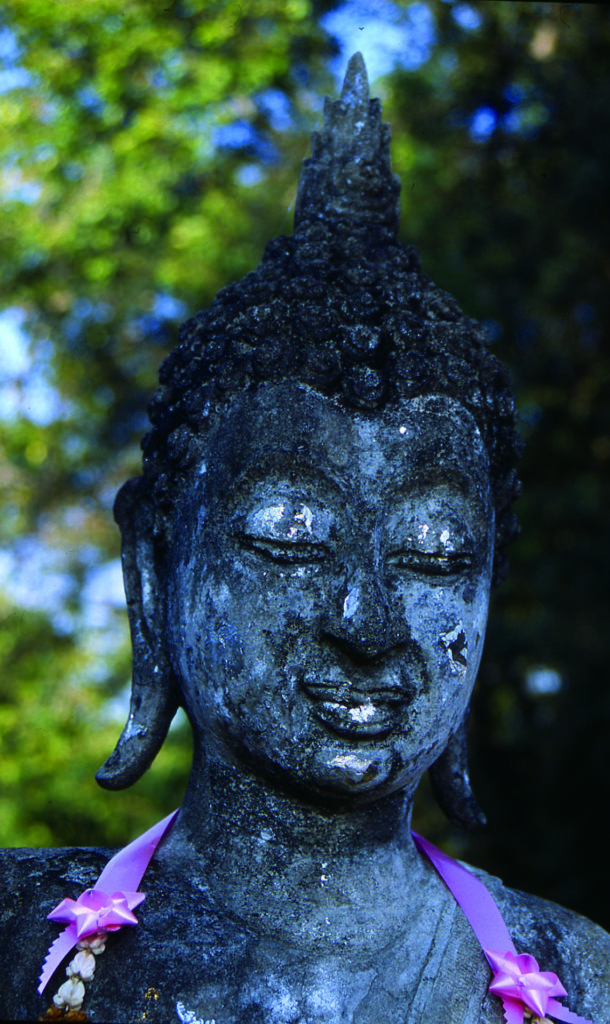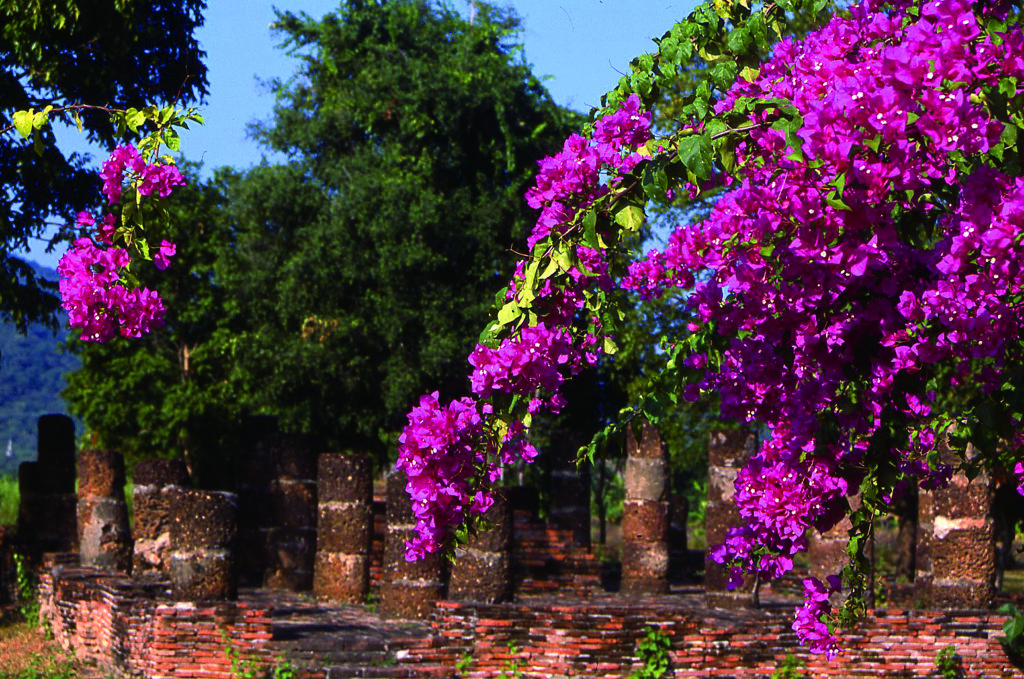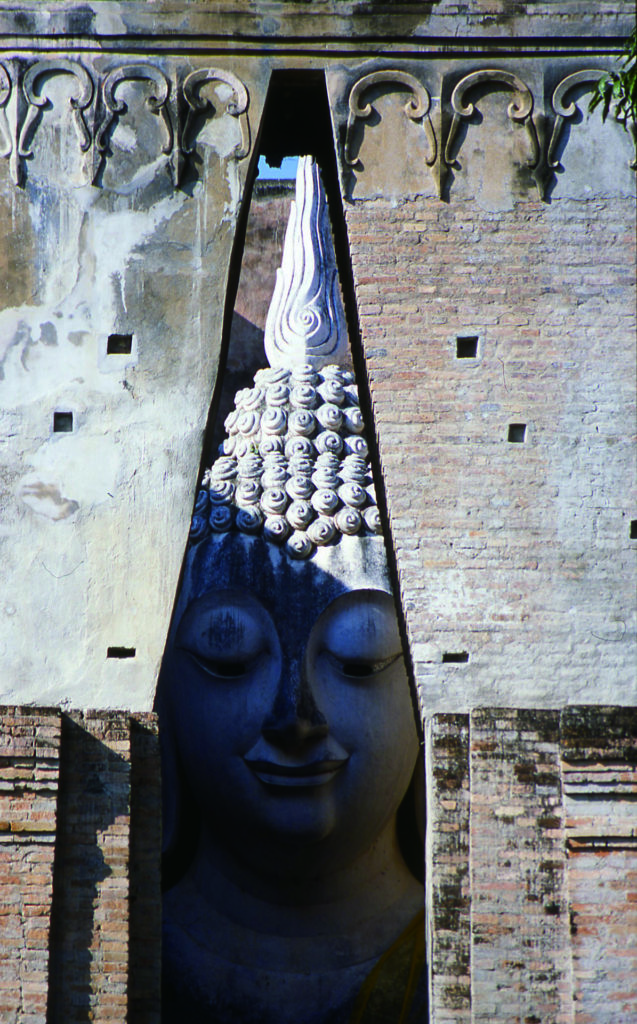Far north of Bangkok, where the hills and fields are green and peaceful, where the ineffable din and smog of the capital are only a faint memory, lies a land rife with the myths of Thailand’s ancient past.

Oral chronicles passed down from generation to generation tell of a legendary Siamese king who could cause barren trees to blossom, or with a single thought turn enemies to stone. His was an enlightened kingdom of beauty, peace and abundance called Sukhothai, “Dawn of Happiness.”
Sukhothai holds a special place in the hearts of the Thai people, for being the first capital dating back to the 13th century when their forefathers wrested it from Khmer rule. As capital of the Kingdom of Siam, Sukhothai pre-dated 15th-century Ayutthaya and 18th-century Bangkok. In its fullest glory for less than a century, the jungle eventually swallowed up the magnificent city and kept it hidden for hundreds of years after its downfall.
Some of Sukhothai’s sacred treasures were brought to Bangkok in the 18th century for safekeeping by the order of King Rama I. A number of them were placed in temples where they still reside today as venerated objects of worship. The following century, a curious prince wandering through Sukhothai’s tangled ruins discovered a stone pillar on which, in 1292, its greatest king, Ramkhamhaeng (Rama the Great), had inscribed for posterity a written record of the major cultural and political achievements of his reign.
Beneath the morass of jungle growth still lay the artistic achievements of a brief place in time, a golden age of architecture and sculpture representing Sukhothai’s one-time political and religious might.
Interest began to grow for this lost land. Around the turn of the 19th to the 20th century, one of the eager visitors to undertake the grueling, month-long overland trip from Bangkok to this fabled place was Lucien Fournereau, a French archeologist. His photographs were later published as a book, Le Siam Ancien. The images show the forest destructively enrooted on temple ruins, and jungle vines entwined in a stranglehold around serene Buddhas and decaying stucco ornaments. It was a sight to both thrill and break the heart.
Through the early decades of the 20th century, stories spread among the cognoscenti that much of old Sukhothai, once one of the largest centers of Buddhism in the world, lay beneath the untamed vegetation of Siam’s north country. If the interest of collectors was aroused by the speculation, so too was the enthusiam of obliging “suppliers” who brazenly and brutally began to gouge the stone statues from the jungle, or simply sever the heads from otherwise immoveable figures. Sukhothai desperately needed a powerful protector.

By mid-century, the relentless pillaging of the site and subsequent appearance of valuable antiquities on the Bangkok market had shocked people in high places into action. As part of a movement to instill pride in traditional Thai culture, the government made a tentative pledge of protection and restoration. Yet the project had barely begun when it was sacrificed, tacitly giving way to the continuing theft of these treasures of Thai heritage.
At last in the 1970s, the active interest of UNESCO and the seed money of international donations encouraged a sizeable commitment from the Thai government and a more modest one from private contributors. Saving old Sukhothai was a gargantuan task fraught with difficulty and danger—from resentful displaced villagers to wild animals, and death threats from the local mafia whose lucrative looting was being curtailed.

Archeology work went ahead by day under the protection of armed escorts, while by night the thievery continued. The area of proposed restoration covered 70 square kilometers and only a handful of men had been allotted to the project. As work advanced, hundreds of craftspeople, laborers and experts were added to the employment roll.
They each brought their individual knowledge and skills to the immense task of restoring the grandeur of old Sukhothai, with its hundreds of structures—temples, stupas, monasteries and palaces—as well as ponds, walls, lawns and moats. Sukhothai Historical Park officially opened in 1988 and was placed on UNESCO’s World Heritage List in 1991, but still today there are more treasures waiting to be unearthed.
Around the park, in the nearby river and fields, there are still fish to be caught and rice to be harvested, as was inscribed so long ago in stone by Rama the Great. Guided by that inscription, trees of mango, tamarind, jackfruit, betel nut and coconut have been faithfully restored to the grounds within the old city walls. An occasional farmer passes through in his bullock cart, appearing much like an image captured on film a century ago by the Frenchman Fournereau. Women cast their quadrangular fishnets into the old city moat, while a young girl grazes her two white cows among the ruins.
A flock of young Buddhist monks in their saffron robes tours the sacred site, seeing for themselves the early Siamese roots of Theravada Buddhism, which was transplanted here from Sri Lanka. And, of course, tourists come too, sometimes renting bicycles to more easily tour the park’s various widespread zones. The human element they provide lends a sense of scale to this overwhelming sight.
In its previous life, Sukhothai is said to have overflowed with people at grand festival times. In the 12th lunar month on the night of the full moon, Loy Krathong, a thanksgiving to the goddess known as the Mother of Waters, was held to celebrate the change of seasons and the abundance of crops. This traditional event is again held here, as it has always been throughout the country, and some say this is the best place to experience it. Beneath the dark sky on that one night a year the temples are lit by hundreds of thousands of candles, bamboo torches and rockets, evoking something of the rich ceremoniality and pageantry that accompanied life here so long ago.
In this placid place by light of day, one is swept away by the impressive Buddhist iconography, and left only to imagine how it might have been before temples crumbled and countless artifacts were spirited away.
The walking Buddha at Wat (temple) Chetuphon, rarely seen in such monumental form, towers over mere mortals with pharaonic power and dignity in spite of its greatly worn features. At the ruins of Wat Si Chum, the recent cleaning of the 11-meter tall seated Buddha revealed splendid mosaic eyes of mother-of-pearl. His right hand is draped over his knee, and its graceful beauty is enhanced by small squares of gold leaf which worshipers have applied as prayer offerings. Overlooking all of Sukhothai is the hilltop Buddha at Saphin Hin. It is there that Rama the Great used to come on his favorite elephant at each new moon and full moon to pay his respects.
The beheaded Buddhas of Wat Phra Luang touch the heart, but most poignant of all is the cluster of small stone feet nestled in the grass nearby, left there where their bodies were rapaciously stolen from them. The sight evokes a sadness for all that has been lost through the centuries at ancient Sukhothai. Yet the world can surely be grateful for what has been saved.
GETTING THERE
Thai Airways has daily flights from Narita to Bangkok, with same day connections to Phitsanulok (about an hour from Sukhothai by taxi or hotel shuttle). Alternately, Bangkok Airways flies from Bangkok to Sukhothai, but with only morning flights an overnight stay in Bangkok is necessary.
WHERE TO STAY
The Pailyn Hotel is situated on the road between the town of Sukhothai and Sukhothai Historical Park. With its swimming pool and excellent restaurant, it is the most comfortable area hotel, and is the most convenient to Sukhothai Historical Park, four kilometers away. A shuttle to the park is available.
Room reservations and airport transfer from/to Phitsanulok or Sukhothai can be arranged with the hotel’s agent. Website: www.asiatravel.com/thailand/pailynsukho




